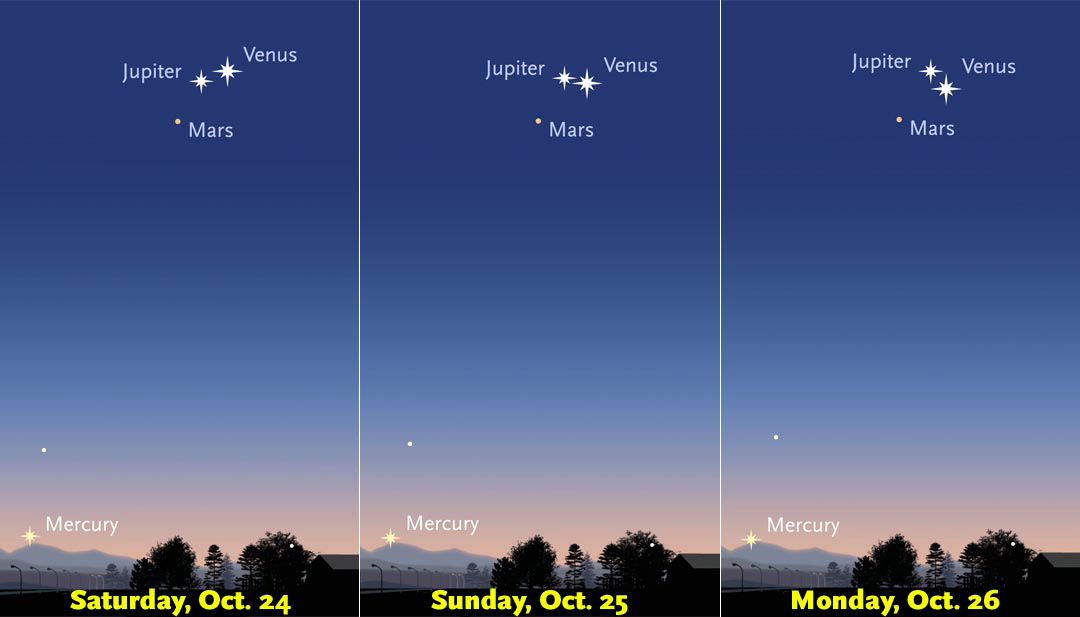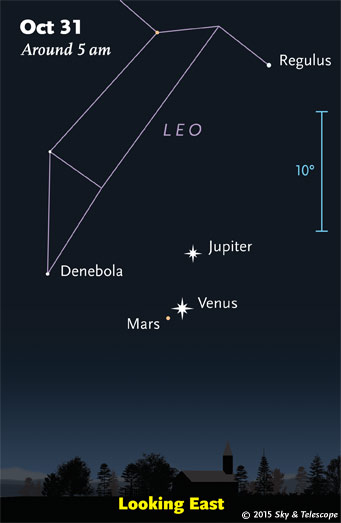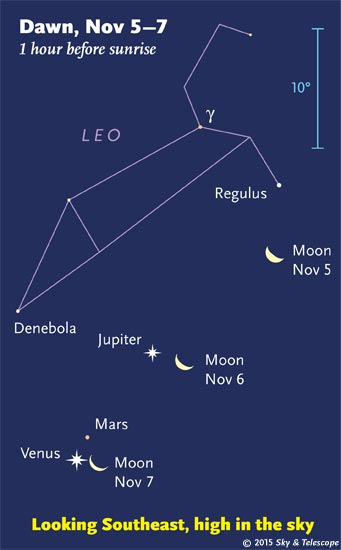Watch three planets pirouette at dawn through patterns that change each morning. And a fourth planet hides down below.

Sky & Telescope diagram


The two brightest planets are drawing close together in the eastern sky before dawn, creating an ever more eye-catching spectacle for early risers.
After weeks of slowly closing in on each other, Venus and Jupiter appear only 2.3° apart on Friday morning (October 23rd) as seen from the North American time zones. That's roughly a thumb's width at arm's length. On Saturday morning the 24th they're only 1.6° apart, about a finger-width.
They'll be closest, in conjunction 1.1° apart, on Sunday and Monday mornings, the 25th and 26th. That's maybe the width of your little finger at arm's length. Venus is the brighter of the two planets.
In addition, little orange Mars glows right nearby. It's much fainter, only 1⁄250 as bright as Venus. Even so, Mars is easy to spot before the sky grows too bright. Look at least an hour before your local sunrise time.1
Mars remains below the two dazzlers this weekend and through the coming week. The three form a "trio," fitting within a circle 5° in diameter, from October 22nd through 29th. Then Venus, descending, catches up with Mars and passes close by it on November 2nd and 3rd, when they'll be 0.8° and 0.7° apart, respectively.
There's more! On the morning of November 6th the waning crescent Moon will pose next to Jupiter, forming a striking pair. Then on the 7th it steps away from Jupiter to cuddle even closer to Venus.
And more! As dawn brightens, look for a fourth planet, Mercury, lurking way down near the horizon below the other three. Don't delay; Mercury is sinking lower day by day.
Planets Bright and Dim
Why are Venus and Jupiter so bright and Mars so faint by comparison?
First, Venus is the closest of the three. On Monday the 26th Venus is 65 million miles from us, compared to Mars's 208 million miles and Jupiter's 560 million miles. Venus is also much nearer to the Sun than the other two, so it's illuminated more intensely. And it's covered with highly reflective white clouds.
Jupiter is much farther from both Earth and Sun, but it's vastly larger than Venus, which goes a long way toward making up for its greater distance and weaker illumination.
Mars is the smallest of the three planets (it's just half the diameter of Earth). And its surface, dark orange-brown, isn't very reflective at all. But its rusty soil does give Mars its distinctive orange tint as seen from your backyard.
Think photo opportunity! Bring a tripod to hold your camera still, because it will want to take relatively long exposures in the dim light. Use a long lens or your maximum zoom to get a decent image scale. Include some tree branches or other foreground for scenery.
1 You can find your local time of sunrise using our online almanac. Be sure to check the daylight-saving time box during October, then uncheck it on the morning of November 1st when standard time returns, if you live where daylight time is observed (most of North America).
Get suggested sky sights for every single night at This Week's Sky at a Glance. To have it delivered to your inbox every Friday afternoon, sign up for our Sky Weekly bulletin.
 0
0









Comments
You must be logged in to post a comment.